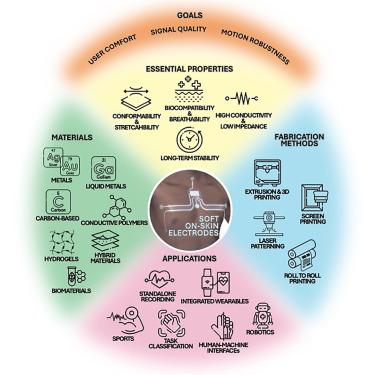Soft skin-interfacing electrodes for wearable bioelectronics
IF 17.5
1区 材料科学
Q1 MATERIALS SCIENCE, MULTIDISCIPLINARY
引用次数: 0
Abstract
Soft bioelectronics patches and wearable e-textiles are rapidly finding their application in electrophysiological and emotional monitoring. This includes real-time electrocardiogram (ECG), electromyogram (EMG), and electroencephalogram (EEG) monitoring, neuroprosthetics, rehabilitation robotics, and everyday human-machine interfaces, which underscore the transformative promise of these soft technologies. Skin-interfacing electrodes have a critical role in these systems, desired to guarantee the signal quality, user comfort, ease of placement, and quality of signal over time. Unlike conventional gel-based electrodes with rigid backing, novel electrodes exploit soft material classes—liquid metals, carbon nanomaterials, intrinsically conductive polymers, ionic gels, and hybrid composites—to create ultrathin and soft architectures that conform intimately to skin microtopography. Such designs not only reduce motion artifacts and skin irritation but also improve comfort for extended use, making them highly attractive for continuous clinical diagnostics, sports performance tracking, and emerging consumer wearables. By bridging materials science, bioengineering, and AI-driven signal processing, soft on-skin electrodes are poised to dominate the next generation of seamless, personalized biosensing technologies. This paper reviews the recent progress on skin-interfacing materials, including conductive composites, hydrogels and liquid metals, soft substrates (polymers and textiles) as well as fabrication and patterning techniques, long-term durability against sweat, bending, and stretching. It also discusses the ongoing challenges in establishing universal test protocols, ensuring environmental sustainability, and integrating soft electronics with data analytics.


用于可穿戴生物电子学的柔软皮肤界面电极
软生物电子贴片和可穿戴电子纺织品在电生理和情绪监测方面的应用正在迅速发展。这包括实时心电图(ECG)、肌电图(EMG)和脑电图(EEG)监测、神经假肢、康复机器人和日常人机界面,这些都强调了这些软技术的变革前景。皮肤接口电极在这些系统中起着至关重要的作用,需要保证信号质量、用户舒适度、易于放置和信号质量随时间的推移。与传统的具有刚性衬底的凝胶电极不同,新型电极利用柔软的材料类别——液态金属、碳纳米材料、本质导电聚合物、离子凝胶和混合复合材料——来创建与皮肤微地形密切相关的超薄和柔软的结构。这样的设计不仅减少了运动假影和皮肤刺激,而且提高了长时间使用的舒适性,使它们对连续临床诊断、运动表现跟踪和新兴的消费者可穿戴设备极具吸引力。通过连接材料科学、生物工程和人工智能驱动的信号处理,柔软的皮肤电极有望主导下一代无缝、个性化的生物传感技术。本文综述了皮肤界面材料的最新进展,包括导电复合材料、水凝胶和液态金属、软基材(聚合物和纺织品)以及制造和图案技术、抗汗、弯曲和拉伸的长期耐久性。它还讨论了建立通用测试协议,确保环境可持续性以及将软电子与数据分析相结合的持续挑战。
本文章由计算机程序翻译,如有差异,请以英文原文为准。
求助全文
约1分钟内获得全文
求助全文
来源期刊

Matter
MATERIALS SCIENCE, MULTIDISCIPLINARY-
CiteScore
26.30
自引率
2.60%
发文量
367
期刊介绍:
Matter, a monthly journal affiliated with Cell, spans the broad field of materials science from nano to macro levels,covering fundamentals to applications. Embracing groundbreaking technologies,it includes full-length research articles,reviews, perspectives,previews, opinions, personnel stories, and general editorial content.
Matter aims to be the primary resource for researchers in academia and industry, inspiring the next generation of materials scientists.
 求助内容:
求助内容: 应助结果提醒方式:
应助结果提醒方式:


